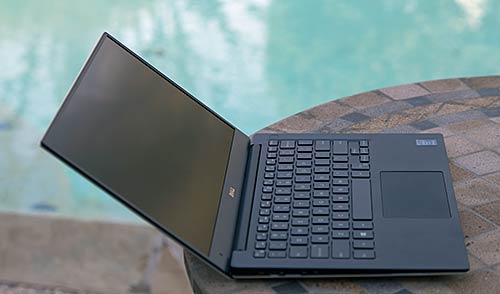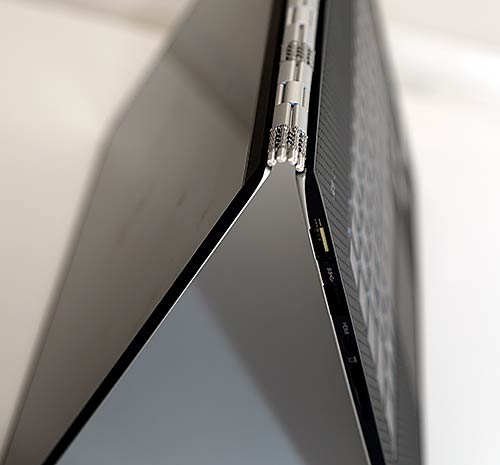|
Even though Lenovo didn't quite hit the pitch of near perfection with their latest high end Yoga convertible, the Yoga 3 Pro, it still garners enough interest to stay in our 10 most popular reviews for months running. It's super thin, extremely light and it has an improved QHD+ 3200 x 1800 display with better yellow rendition than the Yoga 2 Pro. And of course it has that 360 degree swivel hinge that allows for use in tablet, tabletop and laptop positions. The 2015 Dell XPS 13 hit CES 2015 with unexpected and delightful shock and awe: so tiny, just as light as the Yoga 3 Pro, but even faster. And then there's the power frugal Sharp IGZO display, available in your choice of matte full HD non-touch or QHD+ touch. With a price of $1,299 for similarly configured Dell and Lenovo models, even price is a match. So how do you decide?
Do you want a laptop or a convertible?
This is a key point! Some folks just want a laptop and could care less about sliding, swiveling or separating their laptop in two just to have a relatively heavy tablet. Others say "bring it on!" particularly those who've found some love for the Modern UI and Live Tile apps that are designed to work well on tablet-like computing devices. This one is up to you; it's not a pass-fail/right-wrong question. Since the Yoga 3 Pro is relatively light for a convertible at 2.8 lbs., it's not unimaginable to use as a tablet, or even more likely in stand mode on a table while you surf the web or watch a movie. Both the Dell and Lenovo bring traditional laptop ergonomics to your lap or airplane tray table, and they have normal keyboards and trackpads.
Winner: your call.

Size matters to the traveller
Both Ultrabooks are very light by current standards. The non-touch 2015 Dell XPS 13 weighs just 2.6 lbs., making the 3 lb. MacBook Air seem a tad hefty. The touch model weighs 2.8 lbs., which is the same as the Yoga 3 Pro. Either way, you're taking a load off your back and feet. When it comes to size, Dell is the new Sony, finding a way to miniaturize a computer while the competition just stares (Lenovo-NEC will have their chance once the LaVie Z ships). Even better, you won't pay the hefty price premium that Sony charged back in their heyday for smallification. The XPS 13 2015 model, or "new XPS 13" as Dell unspecifically calls it, has the footprint of an 11.6" laptop. For something with full Intel Core U performance, it's impressive and liberating to carry something the size of a netbook that keeps up with well-equipped Ultrabooks.
Winner: 2015 Dell XPS 13

Display
Since Dell offers two very different display options, we give them points for tacitly admitting that crazy high resolution displays on a 13.3" panel are more marketing craze than visual joy given how unevenly Windows programs support HiDPI, and that some folks would like to save money by going with a 1080p display. Not that 1080p is slumming--it's a lovely resolution for smaller panels. Dell's 1080p option allows you to buy an XPS 13 for under $1,000, while Lenovo's pushing the high line with their well configured but pricey $1,299 Yoga 3 Pro. Those who don't want touch and love matte displays will be overjoyed with the 1080p model that's bright, sharp and colorful. However, we ding Dell for not offering a 1080p touch screen option since Windows 8.1 is harder to use without touch.
For 3200 x 1800 QHD+, both the Dell and Lenovo also come with 8 gigs of RAM and a 256 gig HDD. Lenovo uses a second generation Samsung PLS display that doesn't have the sickly yellows of the last gen Samsung panel used on the Yoga 2 Pro. Dell uses a Sharp IGZO panel that's more power frugal, but Dell uses more power management behind the scenes on this panel, and some folks may notice and be bothered by the adaptive contrast and brightness handled at the BIOS level (it doesn't bother me, and I edit photos for our website daily). Both are bright, cover 98% of sRGB for wide color gamut and have very good contrast. I find the Yoga 3 Pro a bit more sensitive to touch.
Winner: depends on your resolution and touch preferences. For QHD+ touch, it's a tie.

Horsepower and Performance
No question, the Dell XPS 13 is the winner here. While both laptops run on fifth generation Intel Broadwell CPUs with integrated graphics, the Lenovo runs on the Core M, a lower power and lower performance platform designed primarily for tablets and thin fanless machines. It's akin to the Y series in the fourth generation Intel Haswell lineup. The Dell XPS 13 runs on Intel Core U series CPUs (Core i3, i5 and i7 are available). These are Ultrabook CPUs with stronger performance than Core M. If you're just working in MS Office, streaming video, browsing the web and editing a few photos and videos here and there, the Yoga 3 Pro is perfectly adequate. But for those who have a heavier workload or multitask heavily, the Dell is your machine.
Interestingly, the Yoga 3 Pro still has a fan, and we actually heard it more often than on the Dell XPS 13. Neither is raucous or hot to the touch though.
Winner: Dell XPS 13 2015
Benchmark Comparisons:
| |
Dell XPS 13 (Core i5) |
Lenovo Yoga 3 Pro (Core M 5Y70) |
| PCMark 7 |
4952 |
4673 |
| PCMark 8 Home |
2841 |
2174 |
| 3DMark 11 |
P 1101 |
P 714 |
As ever, there are more points to cover, so watch our Dell XPS 13 vs. Lenovo Yoga 3 Pro comparison smackdown video to catch them all. My advice? If you want a convertible then the Yoga 3 Pro is your machine. If you're happy working in laptop model at all times, then the new Dell XPS 13 is hard to beat.
|
|

